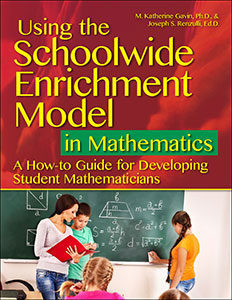Using SEM to Develop Student Mathematicians
Using the Schoolwide Enrichment Model in Mathematics: A How-to Guide for Developing Student Mathematicians
By M. Katherine Gavin, Ph.D., and Joseph S. Renzulli, Ed.D.
(Prufrock Press, 2018 – Learn more)

This roomy 160-page book (8.5” x 11”) shows how to apply strategies of the SEM (Schoolwide Enrichment Model) specifically to the math classroom.
It is aligned with the Mathematical Practices for Common Core State Standards which are the same for grades and states mirroring the Common Core. This book instructs educators how to develop a classroom environment of “enjoyment, engagement and enthusiasm for all students.”

It begins with a chapter entitled “Overview of the Schoolwide Enrichment Model.” Other chapter titles include “Developing Mathematical Talent in Your Students,” “Developing Type II Processes and Skills in Mathematics,” and “Implementing the Enrichment Triad Model in Math – Many Pathways for Learning.”
It also includes chapters specifically devoted to enrichment opportunities in each of the three types.
Involving students in active learning
In chapter 4, Gavin and Renzulli state,
“Developing Type II processes in mathematics means learning and working like a mathematician. This is often far from what a typical math classroom looks like. Often we see the teacher standing in the front of the room, using the math textbook as a guide, and writing … to show students how to do an example. However, this is not how mathematicians work, and this is not how students should be learning mathematics.” (pg 79).
The authors then offer strategies such as “talk moves” and writing in math class to demonstrate how to develop these skills in students.
Chapter 5, “Type II Enrichment in Action,” addresses the critical issue of finding appropriate math content that will enable the teacher to help students develop the desired math skills. It then provides examples of Type II activities that pose rich problems which require both critical and creative thinking with the goal of much deeper understanding of math.
K-12 mathematical investigations
Sections called “View from the Classroom” are included throughout the book. They offer examples of specific mathematical investigations in the classroom. Numerous examples from Primary, Elementary, Middle School and High School classrooms are presented.
Chapter 6 addresses Type III Enrichment, which the authors state is the “capstone of the enrichment triad model” (page 107). Teachers are reminded of their role in this process is to be “a guide, cheerleader and mentor” (page 108). The book explains steps to assist the teacher in identifying student interest, using authentic methodology and making a plan to guide the students toward completion of the project.
SEM for a variety of classroom situations
The authors recognize differences in teacher styles, interests and abilities. They also realize teachers are working within vastly different structures with many types of students. So in the final chapter, they discuss how the Student Enrichment Model may be implemented in a wide variety of environments.
An appendix is included which provides an extensive list of the authors’ favorite resources which should help in planning Type I, II and III enrichment for students.
The back cover claims this book is easy to read and use. Not being proficient or fluent in the terminology of the Schoolwide Enrichment Model, I personally found this to a challenging read. However, the book does provide many practical suggestions, including the previously mentioned views from the classroom along with sample activities which I found to be motivating and informative.
I have already incorporated some classroom discussions and written activities using ideas from the book. I plan to use more ideas as I become more familiar with SEM.
Michael Hernandez is an eighth grade Math and Algebra teacher near Akron, Ohio. He has served on the Ohio Math Model Curricula and Content Advisory Committees. He began his career working with middle school, high school and college students. Through the years, he was “promoted” to the point where his time was spent mostly with adults. Now he is back with the young people he loves whom he has been teaching for 10 years.




























